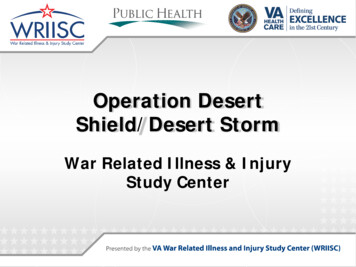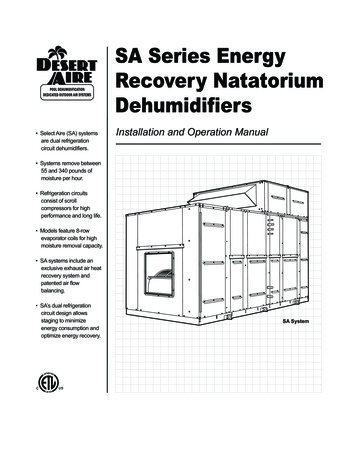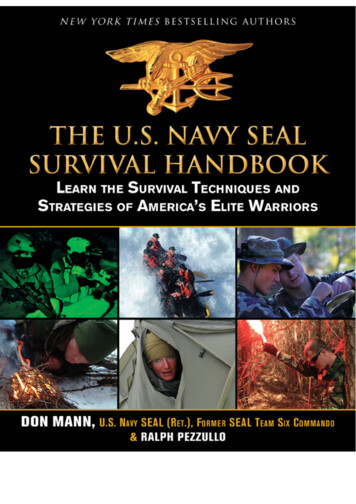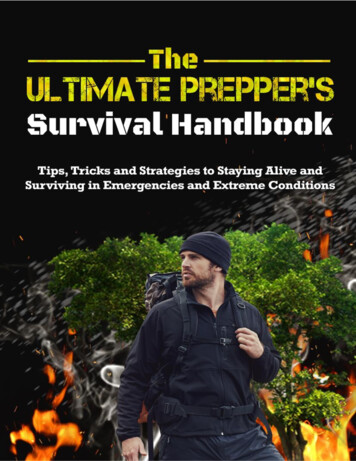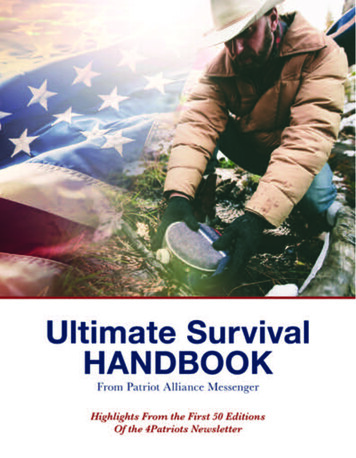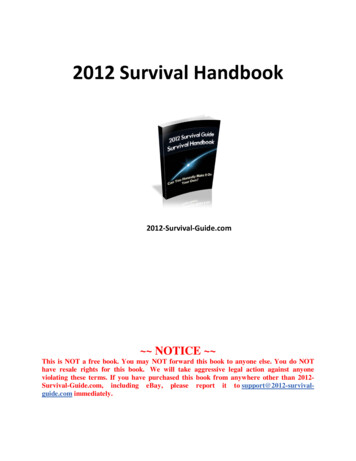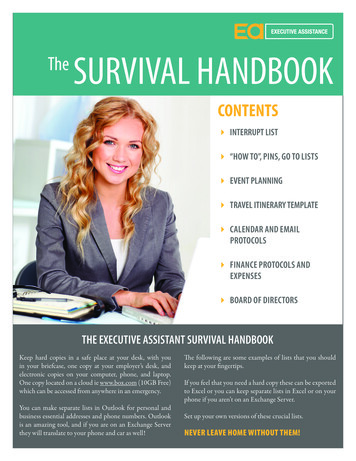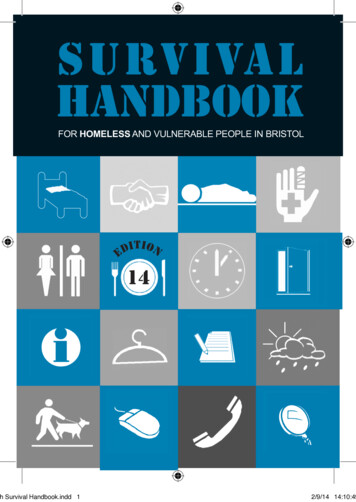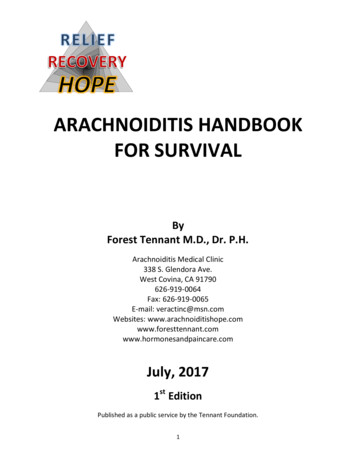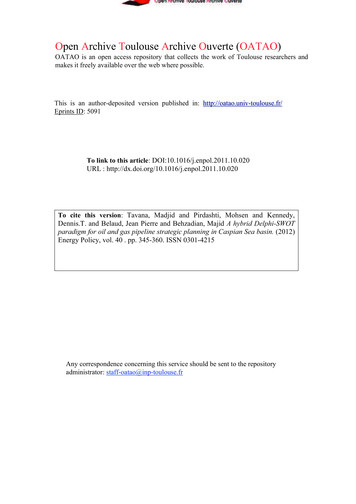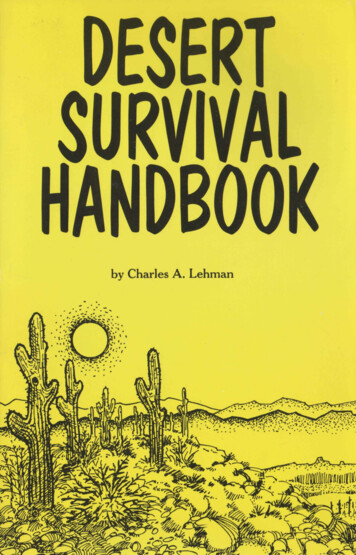
Transcription
DESERTSURVIVALHANDBOOKby Charles A. Lehman
Survival situations can and do happen to average folks, as well as to adventurousexplorers. You have the capacity to handle these situations if you know andfollow the basic principles of survival.This book will get you started. The basics are here. As you project yourself intothe scenarios, play the role, and you will find it's fun to learn about desertsurvival.Finally, carry this book in your backpack, car, boat, airplane, or saddlebag as anextra confidence factor—a security blanket. If you should have a problem, it willbe a handy reference as you wait for rescue, for the weather to clear, or the coolof the desert evening. 1993 by Primer PublishersFourth Printing 1996All rights reserved. No part of this book may be reproduced in any form or by any means, exceptfor review purposes, without written permission of the publisher.Printed in the United States of AmericaISBN 0-935810-34-XPrimer Publishers 5738 North Central Avenue Phoenix, Arizona 85012 (602) 234-1574
Contents1. SURVIVAL? WHO NEEDS IT? Everyone needs to know how to managein unusual and hostile environments. It really can happen to you.2. YOUR BODY IS WHERE YOU LIVE Put priority on protectingyourself from hyperthermia, hypothermia and dehydration.3. TAKE COVER Ideas on how to find natural shelters and ways to build the shelter youneed.4. FIRE UP Combine fire starter, tinder, kindling, and fuel into the right kind of fire.5. MAKE A FUSS Call for help when you need it. Make yourself stand out.6. FIRST THINGS FIRST Setting survival priorities. Always keep your optionsopen. Tell someone where you're going.7. RESCUE AND YOU How search and rescue work. What you can do to help.8. WATER IN WE DESERT How to manage your water resources.9. WHAT TO WEAR The clothes on your back are your first line of defense.10. WHAT TO CARRY Tailor your survival kit to your activity. Select the rightcontainer and contents.11. BUT WHAT ABOUT FOOD? Plants, birds, fish, animals, reptiles, insects.12. DEALING WITH INJURIES AND ILLNESS Pain, shock,bleeding, blisters, fractures, burns, diarrhea, fever.13. WHAT IF? Solving imaginary emergencies will prepare you for the real thing.DESERT SURVIVAL CHECKLIST
CHAPTER 1Survival? Who Needs It?It won't happen to me"Desert survival? Who needs it? Nothing's ever happened to me." "I never get more than a fewmiles from a main highway. What do I care about survival?" These are some typical responsesheard on the subject of this book.Okay, you need the skills outlined here only if you: Drive through desertsBackpack in the desertFish desert reservoirsFly a light planeHang glide Live near a desertHike in the desertWatch desert birdsHunt in the desertRide horsebackPeople tend to think survival is a primitive "live-off-the-land" skill needed by explorers. Mostassume that since they don't fit into that category they don't need the skill.
Survival is really nothing more than managing your own mind and body in an unusual or hostileenvironment—and you can find yourself in that position, no matter who you are or what you do.Suppose you are driving from El Paso to Phoenix along Interstate 10. About noon the utter boredom offreeway driving and the haunting beauty of the desert tempt you to take a "short-cut." You take the firstexit, drive south about five miles, then turn west on a well-maintained road. Paralleling the freeway ismuch more pleasant, and your air conditioner keeps you in perfect comfort as mile after mile of colorfuldesert rolls by.You check the rearview mirror to insure that this magnificent scenery is yours alone. No cars behind—butthere is a white cloud billowing out behind the car. The bright red "HOT" light flashes on the instrumentpanel. Blown radiator hoses are common in the best of cars.A blast of oppressive heat almost takes your breath away as you step from the driver's seat. One of the localradio stations mentioned a temperature of 115 just before you shut off the overheated engine.But it feels much hotter. In the last hour you passed one ranch— about twenty-five minutes back— and mettwo cars just after you left the freeway.You are only about five miles from the freeway, but you're quite isolated. This is a bonafide survivalsituation growing out of everyday life. How would you insure your survival in the searing desert heat?Select the one best answer. a.Begin walking toward the freeway and hail a passing car. b.Strip off as many clothes as possible to help beat the heat, then walk slowly back downthe road looking for help. c.Stay in your car. d.Get in the shade, wait until dark, then walk out.The answer is d. You'll find the reasons in Chapters 2 and 3.Survival situations can and do happen to average folks, as well as to adventurous explorers. Youhave the capacity to handle these situations if you know and follow the basic principles ofsurvival.This book will get you started. The basics are here. As you project yourself into the scenarios,play the role, and you will find it's fun to learn about desert survival.Finally, carry this book in your backpack, car, boat, airplane, or saddlebag as an extra confidencefactor—a security blanket. If you should have a problem, it will be a handy reference as you waitfor rescue, the weather to clear, or the cool of the desert evening.
CHAPTER 2Your Body Is Where You LiveDesert survivors face many hazards, but only four present any immediate danger—heat, cold,dryness and injuries. If you enter your personal survival situation without getting hurt orasphyxiated, there are only three conditions which can pose immediate threats to your life(managing injuries is a separate subject and is covered in Chapter 12).Hyperthermia, dehydration, and hypothermia, are the three dangers. Prevent them and you aregoing to come home little the worse for wear. All three boil down to taking care of your body—that is where you live.Your body is something like the engine in your car. Supply it with the proper fuel, adequatecooling and efficient lubricants and it will run for years. Neglect any one of these and you areheaded for trouble.Hyperthermia, or overheating your body can be as disastrous as "over-temping" your car'sengine—both can cause seizure of the machine. Fortunately, your body has a marvelous coolingsystem, capable of keeping your temperature stabilized around 99 degrees, even in the hottestdesert. It can be overtaxed, though, unless you are careful.Food heats your body; perspiration, breathing, and radiation cool it.Let's say you were on an early morning hike in the desert west of Las Vegas, about ten miles offInterstate 15. You get disoriented. It is now noon and the temperature is 120? You are in noimmediate danger—but wrong moves can do you in.Naturally, you are eager to get back to civilization and the excitement and tables of Las Vegas.However, if you rush around trying to find your way or set out for the highway, you can easilyovertax your cooling system. If you work so hard that most of your
sweat is running off rather than evaporating, your temperature will begin to rise. As it does, yourbody's heat-regulating mechanism in the brain ceases to function and you stop sweating. Yourskin flushes and becomes dry. Suddenly, you collapse—the classic "heat stroke." Withouttreatment, death may follow.It's quite obvious that you cannot treat your own heat stroke. You have to prevent yourtemperature from getting too high. In hot weather that means severely limiting your physicalactivity, wearing your clothing loosely (but wearing it), staying in the shade, and drinking plentyof water.The trouble is, survival conditions can impose serious limitations on your ability to do thesethings. You may have to build your own shade and you may not have "plenty of water." Still,you should be aware of the danger of heat and keep heat management high on your list ofpriorities.
Although heat stroke is the most dangerous form of hyperthermia, heat can also cause otherproblems unless you act to prevent them.Heat cramps can be painful and disabling. They are not true hyperthermia, because your bodytemperature may still be normal when they occur. If you have been working hard and sweating alot, you are losing more than water. Even if your body can maintain its temperature, it willdeplete its supply of water and salts (also called electrolytes, because when dissolved in waterthey form the conductive medium for electrical nerve impulses). You may drink plenty of water,but unless you also take in food or salt, the change in electrolyte balance may cause your musclesto cramp.In a survival situation, you avoid cramps the same way you prevent true hyperthermia—bystaying out of the sun and resting as much as possible. Sweat and salts are difficult to replaceunder survival conditions, so consider each a precious resource—too valuable to waste.Perspiration is the common thread that ties together two of your immediate survival hazards:overheating and dehydration. Your body sweats to prevent hyperthermia, but even when it issuccessful, it dehydrates itself in the process. Unless you control this dehydrating effect, you cancause yourself an awful lot of grief.Picture yourself stranded in a desert area during winter. You scurry around all day building asnug shelter for yourself and your companion. Both of you have worked hard on the lean-to andgathered firewood for the night; you were smart enough to avoid getting your clothes wet withsweat by stripping off a layer or two as you worked. Around noon you each ate one of thesandwiches you had packed for the trip.
In the evening your cheerful fire and cozy shelter have you feeling pretty good. "This survivalbusiness isn't bad at all. We're comfortable for tonight, and tomorrow there's sure to be someoneout looking for us." Your partner does not answer and seems unusually quiet. "Bill, what's thematter—you look sick." Bill doesn't look up, but mutters, "Yeah, it's my stomach. I feel like I'mgoing to lose that sandwich— and that's all the food we've got."If you were stranded during the summer, you might suspect Bill's problem—and yours. It iswater, or rather the lack of it.Dehydration is the culprit. Working vigorously in the dry air, you and Bill were perspiring, butyou did not notice because your sweat evaporated quickly. Every breath you exhaled took somewater vapor with it. Those beef sandwiches were delicious and good for you, but the few sips ofthermos coffee you washed them down with did nothing to help. Digesting the protein in the beeftook far more fluid from your body than the coffee added.Dehydration is sneaky. There are early symptoms of the problem, but you are not apt to noticethem if you are busy. A feeling of thirst is a very unreliable indicator. Oh, you'll get thirsty all
right as you start to dehydrate. The problem is that just a few sips will often quench the thirstwithout improving your internal water deficit. Or you may not notice the thirst in the first placebecause you are distracted. Being marooned in strange surroundings can be quite distracting.If your natural thirst fails to spur you to drink enough water to rebalance your electrolytes, youwill probably begin to notice a rather vague discomfort—again, not unusual for a survivor. Asyou use up more of your body's water, you will find it is more comfortable to move slowly or notat all than to hustle about your chores. If you glanced in a mirror you'd notice your skin was a bitred, but you probably would pass that symptom off as sunburn or windburn. You will becomeimpatient, too; but who wouldn't with no rescue in sight. So you still have no reliable indicatorthat all is not well.Loss of appetite along with increased pulse and respiration will also occur, but you're not likelyto notice because your isolated situation may trigger the same responses.At a water loss of about five percent of your body weight, you will get sick—just plainmiserable. Waves of nausea will destroy all desire to drink. If you vomit, you will lose additionalquantities of water. Then things start downhill in a hurry. You are losing fluid, you can't or won'tdrink, and the symptoms get worse.As water loss continues, more noticeable symptoms will begin to appear. You may get dizzy,develop a severe headache, become short of breath, experience tingling extremities, a dry mouth,"thick" speech and become unable to walk. Dehydration at this level is extremely dangerous.You have to prevent it.In a desert survival episode, water may be scarce or nonexistent. If so, your safest bet is to beextremely stingy with the supply stored inside you. There is little you can do to reduce somewater losses. You will lose almost two quarts of water each day through urination, breathing, andbowel movements. If you eat, more water will be used to digest the food. Eating is controllable.So is the other big water thief—sweating. When you're a survivor, perspiration is your enemy. Itrobs you of the water supply stored in your body and fouls up your electrolytic balance.If you have water—drink it, don't ration or save it. People have died in the desert with water intheir canteens. They rationed that water while their bodies dehydrated and quit working for them.Unless you have lots of water available, eat sparingly and don't work up a sweat. Read moreabout water in Chapters 6 and 8.The third hazard, hypothermia, is a lowering of the body's core temperature. You are designedto operate at about 99 degrees Fahrenheit. Drop that temperature even a few degrees and themachine starts to break down.The desert cools off rapidly as soon as the sun sets. Suppose you have a flat tire at night on alonely road. While you are struggling with the spare, a soft rain starts. There is a wind comingup, too. By the time you discover the spare is flat, you're soaked.
Eventually, another car stops to pick you up; by then, you are shaking like a leaf. You have neverfelt so cold. That's hypotherm
SURVIVAL HANDBOOK by Charles A. Lehman . Survival situations can and do happen to average folks, as well as to adventurous explorers. You have the capacity to
